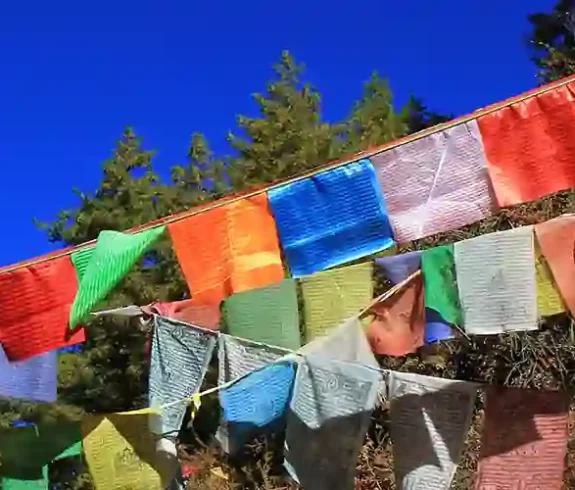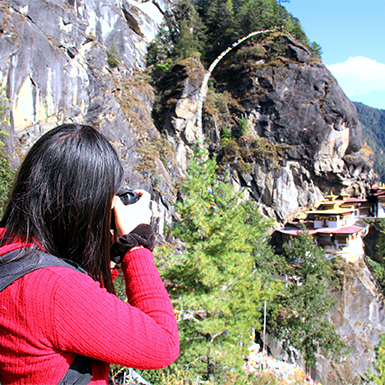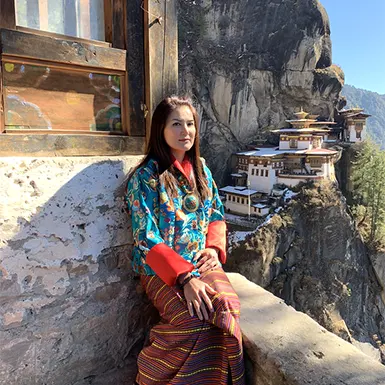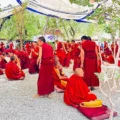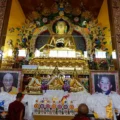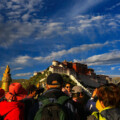Tibetan Buddhists revere Guru Rinpoche Padmasambhava as a guiding light of wisdom and compassion. He holds legendary status for introducing Buddhism to Tibet and firmly establishing its roots. This 8th-century tantric master’s knowledge and extraordinary abilities inspire and guide countless individuals today.
Lopon Rinpoche’s influence transcends Tibet’s borders, reaching far and wide across the Himalayan region. His teachings have shaped the spiritual landscapes of Bhutan and Nepal, leaving an enduring mark. He is not just a figure of the past but a living presence, inspiring devotees in their pursuit of enlightenment.
Why “Guru Rinpoche”? Decoding the Name’s Significance
The name “Guru Rinpoche” speaks volumes about his revered status. In the Tibetan language, it means “Precious Master” or “Precious Guru,” a title that reflects the profound respect and devotion Tibetans hold for him. He is seen as a second Buddha, embodying the qualities of wisdom, compassion, and skillful guidance.
The moniker “Precious Master” goes beyond a mere title; it signifies a deep bond between Lopon Rinpoche and his followers. His teachings, often concealed as “terma” treasures, are regarded as priceless gems of wisdom waiting to be unearthed and cherished. This enduring legacy of teachings continues to illuminate the path for spiritual seekers on their tour to awakening.

Miraculous Life that Shaped Tibetan Buddhism
Legends and history intertwine in the captivating story of Guru, a central figure in Tibetan Buddhism. Padmasambhava, known in India as a master of tantric practices, was born miraculously from a lotus blossom in the 8th century and emerged with remarkable abilities. His tour to Tibet marked a pivotal moment, forever shaping the landscape of Buddhism in the region.
Born of a Lotus: A Glimpse into the Miraculous
Tales of wonder surround Lopon Rinpoche’s birth. According to tradition, he spontaneously materialized within a lotus flower on Dhanakosha Lake in the ancient kingdom of Oddiyana. This extraordinary beginning foretold his destined role as a spiritual guide, illuminating the path to enlightenment for countless beings.
A Sacred Journey: Bringing Buddhism to the Roof of the World
King Trisong Detsen of Tibet, seeking to establish Buddhism in his land, was summoned to begin a sacred mission. The tour was fraught with challenges, as he encountered opposition from local spirits and forces. However, his mastery of tantric practices allowed him to overcome these obstacles, paving the way for Buddhism to take root in the hearts and minds of the Tibetan people.
Samye Monastery: A Cornerstone of Tibetan Buddhism
Lopon Rinpoche’s accomplishments include founding Samye Monastery, the first Buddhist monastery in Tibet. This groundbreaking institution became a vibrant learning and spiritual development center, solidifying Buddhism’s presence in the region. Samye’s establishment laid the foundation for the diverse and rich traditions of Tibetan Buddhism that continue to thrive today.
A Living Legacy: The Nyingma Tradition
Rinpoche’s teachings became the cornerstone of the Nyingma tradition, the oldest of the four primary schools of Tibetan Buddhism. He transmitted a vast and profound knowledge, encompassing tantric practices, rituals, and philosophical teachings. He hid many of these teachings as “terma” treasures to be discovered in the future, ensuring their preservation and continued relevance.
Miracles and Inspiration: A Master’s Spiritual Power
The life of Lopon Rinpoche is filled with accounts of extraordinary events, often referred to as Rinpoche miracles, which demonstrate his spiritual mastery. These stories, passed down through generations, depict him as a being who could control the elements, subdue evil forces, and radiate boundless compassion. Whether viewed as literal events or symbolic narratives, these accounts serve as a testament to his immense spiritual power and continue to inspire deep devotion in his followers.
A Beacon of Tantric Wisdom and the Nyingma Lineage
Guru Rinpoche Padmasambhava made profound spiritual contributions, highlighting his role in Tibetan Buddhism. His teachings, deeply rooted in the tantric tradition, transformed the region’s spiritual landscape and continue to inspire practitioners globally. Establishing the Nyingma school, the oldest of the four main Tibetan Buddhist lineages is a cornerstone of his legacy.
Unveiling Hidden Wisdom: The Tantric Path
People celebrate Lopon Rinpoche’s mastery of tantric Buddhism, which emphasizes transforming ordinary experiences into profound spiritual insights. His teachings encompassed a diverse array of practices, including:
- Deity Yoga: Visualization and identification with enlightened figures to awaken innate wisdom.
- Mantra Recitation: Repetition of sacred sounds to purify the mind and access deeper states of consciousness.
- Mandala Offerings: Symbolic offerings cultivating generosity and devotion.
- Guru Yoga: Devotional practices focused on connecting with the wisdom and blessings of the teacher.
Often considered advanced, these tantric practices offer a robust framework for spiritual development and realization of one’s Buddha nature. Through his teachings, Rinpoche empowered practitioners to engage directly with life’s challenges and energies, transforming them into opportunities for growth and awakening.
Ancient Wisdom Preserved: The Nyingma School
Guru Rinpoche Padmasambhava’s spiritual legacy found its home in the Nyingma school, the oldest of the four primary schools of Tibetan Buddhism. The Nyingma lineage, translating to “Ancient Ones,” is recognized for its emphasis on:
- Terma Tradition: Discovery and transmission of hidden teachings concealed by Lopon Rinpoche for future generations.
- Dzogchen: A profound meditation practice aimed at recognizing the inherent perfection of the mind.
- Nine Yanas: A comprehensive classification of Buddhist vehicles or paths, each offering unique approaches to enlightenment.
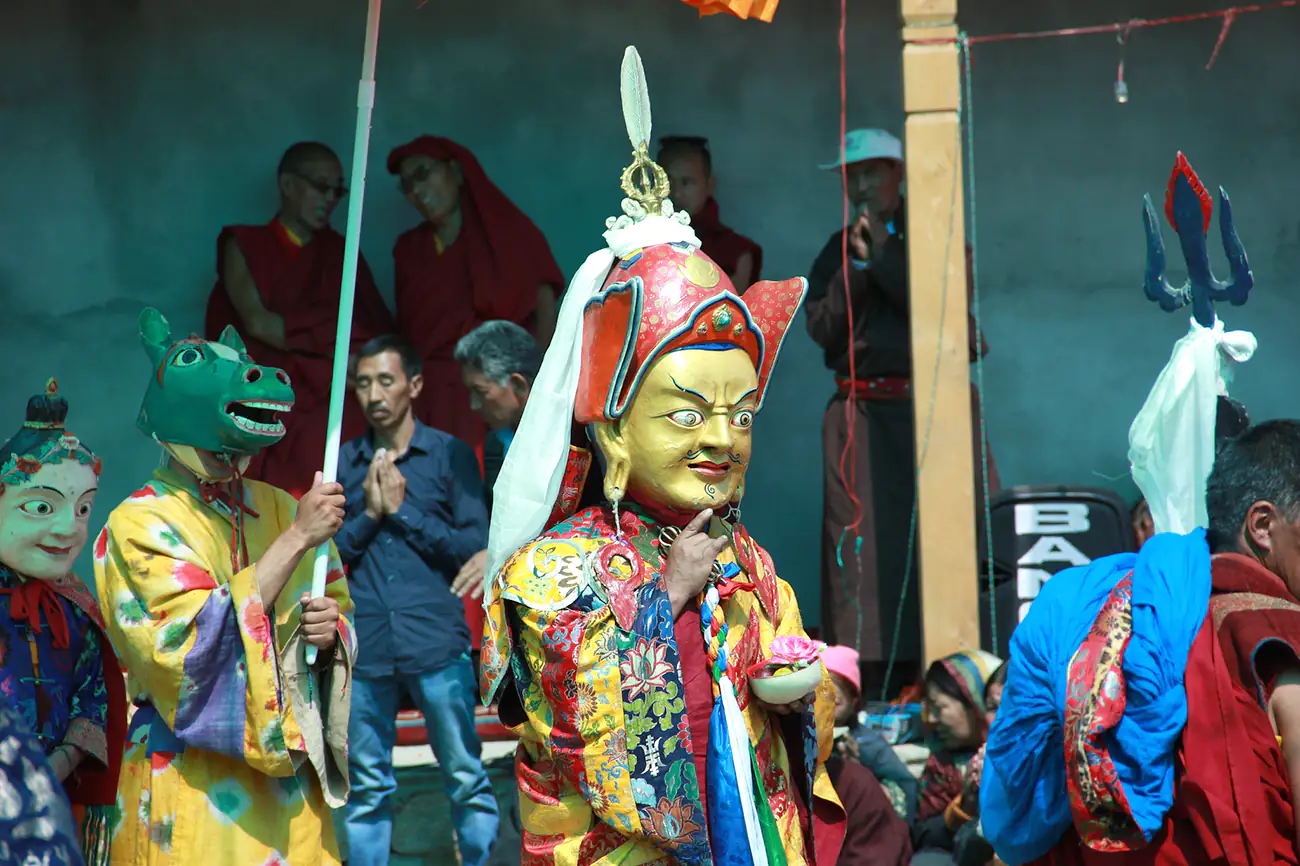
Legends and Miracles of the Precious Master
The life in Tibetan Buddhism unfolds as a vibrant tapestry woven with legends and miraculous tales. These stories, passed down through countless generations, offer a glimpse into his extraordinary abilities and profound impact on the spiritual landscape of Tibet and beyond. They serve as an eternal source of inspiration for his followers, affirming the power of faith and dedicated practice.
Subduing Darkness: Pioneering Buddhism in Tibet
A captivating legend recounts a courageous confrontation with demonic forces that plagued Tibet upon his arrival in the 8th century. These entities threatened to impede the spread of Buddhism. Still, Lopon Rinpoche’s mastery of tantric practices allowed him to alleviate and transform these negative energies into dharma protectors. This legend symbolizes the triumph of wisdom and compassion over ignorance and adversity.
Miracles Unveiled: A Testament to Guru Rinpoche’s Spiritual Power
Numerous miraculous feats attributed to Padmasambhava showcase his profound spiritual prowess. Among the most celebrated stories are:
- Soaring Through the Heavens: Legends describes Lopon Rinpoche effortlessly flying through the air on his tour to Tibet, symbolizing his transcendence of earthly limitations.
- Sacred Markings: Many believe the handprints and footprints on rocks near sacred sites are evidence of his presence and blessings.
- Commanding the Elements: Accounts tell of Guru Rinpoche calming raging storms, creating life-giving springs, and even causing vibrant flowers to bloom amidst snowy landscapes, demonstrating his mastery over the natural world.
- Taming Malevolent Forces: Numerous stories depict Guru Rinpoche Padmasambhava’s ability to alleviate and transform demonic beings, guiding them towards righteousness and becoming dharma protectors.
- Treasures of Wisdom (Terma): Lopon Rinpoche’s legacy includes concealing sacred teachings (terma) for future generations to discover, ensuring the continued transmission of his wisdom, and preserving his spiritual lineage.
Sacred Journeys: Retracing the Steps of the Master
Across Tibet and the Himalayas, numerous sacred sites intimately link to Rinpoche’s life and miraculous deeds. These pilgrimage destinations hold immense spiritual significance for Buddhists, providing opportunities for introspection, devotion, and a deeper connection to their enduring legacy. Notable pilgrimage sites include:
- Samye Monastery: Samye Monastery is the first Buddhist monastery in Tibet that he established.
- Tso Pema (Rewalsar Lake): A revered lake in India believed to be the birthplace.
- Tiger’s Nest Monastery (Paro Taktsang): Tiger’s Nest Monastery (Paro Taktsang), a breathtaking cliffside monastery in Bhutan, is associated with Lopon Rinpoche’s meditation retreat.
Pilgrimage Guide to the Precious Master’s Legacy
Rinpoche’s spiritual legacy transcends his teachings and miracles, permeating sacred sites throughout the Himalayas. These pilgrimage destinations offer a profound connection to the essence of this revered figure, deepening our understanding of his teachings and offering blessings to those who visit. This guide takes you to key locations associated with Lopon Rinpoche, unveiling his enduring legacy.
Tibet: The Heart and Soul of Rinpoche’s Legacy
Tibet, the land where Guru Rinpoche left an enduring mark, boasts numerous sacred sites that attract pilgrims from all corners of the globe:
- Samye Monastery: Padmasambhava founded the first Buddhist monastery in Tibet, solidifying his pivotal role in establishing Buddhism in the region.
- Chimpu Caves: Pilgrims seek blessings and spiritual insights, where Lopon Rinpoche meditated and left his handprints and footprints behind.
- Tsechu Monastery: This monastery, adorned with a revered statue of Rinpoche and murals depicting his life and teachings, offers a space for quiet contemplation and devotion.
- Beyul Pemako: This hidden land, believed to be a pure realm blessed by Padmasambhava, attracts spiritual seekers yearning for enlightenment and liberation.
Bhutan: Land of the Thunder Dragon, Blessed by Rinpoche
Bhutan, deeply rooted in Tibetan Buddhism, holds several sites sacred to Lopon Rinpoche:
- Tiger’s Nest Monastery (Paro Taktsang): Legend tells of Guru Rinpoche meditating and subduing local deities at this dramatically perched cliffside location. Its stunning vistas and tranquil atmosphere draw pilgrims seeking contemplation and blessings.
- Kurjey Lhakhang: This temple complex houses a cave where Padmasambhava meditated, leaving his body imprint behind. Pilgrims visit this site for retreats and prayers and to connect with its deep spiritual significance.
- Singye Dzong: Believed to be one of Padmasambhava’s hidden lands (beyul), this remote and pristine region requires a challenging trek. Pilgrims undertake this tour to seek blessings and connect with the sacredness of the natural world.
Nepal: Tracing the Footsteps of Guru Rinpoche
Nepal, rich in Buddhist heritage, also features significant pilgrimage sites attracting devotees from around the world:
- Asura Cave (Pharping): This cave, located near Kathmandu, is revered as the place where Padmasambhava achieved enlightenment. It serves as a potent space for meditation and spiritual practice.
- Maratika Cave: Situated in eastern Nepal, this cave connects to Padmasambhava’s teachings on peaceful and wrathful deities. Pilgrims visit to seek blessings and overcome obstacles on their path.
- Muktinath: This high-altitude temple complex, sacred to Buddhists and Hindus alike, is said to have been visited by Lopon Rinpoche during his travels, making it a place of deep spiritual significance.
The Pilgrimage Experience: A Journey of Transformation
Visiting these sacred sites offers a unique opportunity to connect with the essence of Rinpoche’s teachings. Pilgrims often engage in practices such as:
- Circumambulation: Walking mindfully around sacred sites with reverence.
- Prostrations: Physical acts of bowing to show respect and humility.
- Offerings of Butter Lamps and Incense: Symbolic gestures of devotion and prayer.
- Mantra Recitation: Chanting sacred sounds to invoke blessings and purify the mind.
- Meditation and Reflection: Engaging in contemplative practices to deepen spiritual understanding.
Cultural Icon Shaping Tibetan Heritage
The influence of Lopon Rinpoche, the revered figure in Tibetan Buddhism, transcends his spiritual teachings. He has become a cultural icon, deeply interwoven into the fabric of Tibetan society. His presence permeates art, literature, religious practices, and festivals, leaving a lasting imprint on the cultural landscape.
Artistic Expressions: Honoring the Precious Master
Tibetan art flourishes with depictions of Padmasambhava, often portraying him in serene or wrathful forms. These artistic expressions are visual reminders of his teachings, inspiring devotion and awe.
- Thangkas: Tibetan artists meticulously craft these intricately painted scrolls, often featuring Lopon Rinpoche in various manifestations, surrounded by deities and symbols. They use them for meditation, teaching, and as focal points for devotion.
- Status: Sculptures of Guru Rinpoche adorn monasteries, temples, and homes. These statues, which range from small personal altars to monumental figures, are crafted from metal, wood, and clay, reflecting the deep reverence for the Precious Master.
- Murals: Monasteries and temples across Tibet showcase vibrant murals depicting scenes from Lopon Rinpoche’s life, his teachings, and the miracles he performed. These murals adorn sacred spaces and serve as visual narratives that educate and inspire.
Literature and Oral Traditions: Passing Down Guru Rinpoche’s Legacy
Tibetans preserve Padmasambhava’s life and teachings in a vast written and oral literature collection. These texts encompass historical accounts, hagiographies rich with miraculous stories, and profound teachings.
- The Pema Katang: This extensive biography of Padmasambhava chronicles his life, teachings, and extraordinary acts. A cornerstone of Nyingma literature, it serves as a wellspring of inspiration for practitioners.
- Terma Texts: Over centuries, tertöns (treasure revealers) have unveiled these hidden teachings, offering unique insights into Rinpoche’s wisdom and practices.
- Oral Traditions: Oral traditions, rich with stories and songs about Padmasambhava, have been passed down through the ages, ensuring his legacy remains vibrantly alive in the hearts and minds of the Tibetan people.
Festivals: Celebrating Rinpoche’s Legacy
His influence shines brightly in various Tibetan festivals, especially those connected to the Nyingma tradition. These celebrations feature vibrant rituals, masked dances, and communal gatherings, strengthening the bond between Padmasambhava and his devoted followers.
- Tsechu: These annual festivals at different monasteries across Tibet commemorate Lopon Rinpoche’s birth and activities.
- Dungdrub: This intensive practice delves deep into Lopon Rinpoche’s teachings, incorporating elaborate rituals, visualizations, and recitations.
- Padmasambhava Day: Tibetans celebrate this special day to honor Padmasambhava’s birth with prayers, offerings, and joyous festivities.
Modern World: A Timeless Beacon of Wisdom
His wisdom reaches far beyond ancient texts and into the lives of modern practitioners. His presence remains active in contemporary Tibetan Buddhism, guiding and inspiring individuals worldwide. The Precious Master’s teachings and extraordinary life resonate deeply in our present time.
Alive in the Tibetan Buddhist Tradition
Guru Rinpoche Padmasambhava’s influence permeates every aspect of modern Tibetan Buddhism. He is not just a figure from the past but a living embodiment of wisdom and compassion. Countless individuals actively transmit and practice his teachings, particularly those of the Nyingma tradition.
- Daily Devotions: Guru Rinpoche’s mantra, “Om Ah Hung Vajra Guru Padma Siddhi Hung,” resonates daily in the hearts and voices of devotees who seek his blessings and protection.
- Rituals and Practices: Elaborate rituals and practices honoring Padmasambhava fill monasteries and homes. These rituals often incorporate visualization, offerings, and chanting of sacred texts.
- Uncovering Hidden Teachings: New terma teachings, concealed by Padmasambhava and unveiled by tertöns (treasure revealers), continue to emerge, providing fresh insights and guidance for practitioners.
Modern Guidance from Ancient Teachings
Rinpoche’s teachings offer practical wisdom for navigating the complexities of modern life. His emphasis on compassion, understanding, and skillful action provides a roadmap for personal growth and the cultivation of inner peace.
- Nurturing Compassion: Lopon Rinpoche’s teachings encourage cultivating deep compassion for all living beings. This practice involves empathizing with others’ suffering and working to alleviate it.
- Developing Wisdom: In Buddhist philosophy, wisdom is understanding the true nature of reality. Padmasambhava’s teachings provide methods for generating this wisdom through meditation, reflection, and study.
- Practicing Skillful Means: Padmasambhava emphasized the importance of skillful means in approaching different situations and individuals. This approach involves effectively adapting methods to guide others toward spiritual growth.
Practical Ways to Connect with Guru Rinpoche Padmasambhava
Modern practitioners have various avenues to connect with Lopon Rinpoche and draw inspiration from his life and teachings:
- Meditation: By visualizing and reciting his mantra, practitioners can cultivate a deeper connection to his wisdom and blessings.
- Study: Exploring his teachings through texts and commentaries can deepen our understanding and guide our practice.
- Pilgrimage: Visiting sacred sites associated with Lopon Rinpoche can be a transformative experience, allowing practitioners to connect with his energy and receive blessings.
- Shared Practice: Participating in group practices and rituals dedicated to Padmasambhava fosters community and shared devotion.
Guru Rinpoche’s Teachings: Unveiling the Hidden Treasures of Wisdom
Guru Rinpoche, also known as Padmasambhava, is revered for his profound teachings and enduring impact on Tibetan Buddhism. His wisdom, encapsulated in a vast collection of texts and oral traditions, continues to guide and inspire practitioners of the Vajrayana path. Central to his legacy are the terma texts, hidden treasures of knowledge meant to be discovered and revealed over time.
Key Texts and Teachings of Guru Rinpoche
Padmasambhava’s teachings encompass various topics, from philosophical treatises to practical instructions for meditation and ritual practices. Some of the most notable texts attributed to him include:
- The Pema Katang: This extensive biography of Lopon Rinpoche details his life, teachings, and miraculous deeds. It is a cornerstone of Nyingma literature and a source of inspiration for practitioners.
- The Bardo Thodol (Tibetan Book of the Dead): This text guides individuals through the stages of death and rebirth, offering instructions for navigating the intermediate state (bardo) and attaining liberation.
- Sadhanas: Padmasambhava revealed numerous sadhanas, or ritual practices, focused on different deities and aspects of Vajrayana Buddhism. These practices provide a structured approach to spiritual development.
- Dzogchen Teachings: Padmasambhava is considered a key figure in the transmission of Dzogchen, a profound meditation practice that emphasizes recognizing the inherent perfection of the mind.
Terma: Hidden Treasures of Wisdom
A unique aspect of Guru Rinpoche’s legacy is the tradition of terma or hidden treasures. These are teachings and sacred objects that Lopon Rinpoche concealed to be discovered by future generations when the time was ripe. Tertöns, or treasure revealers, have unearthed these terms over the centuries, enriching the Nyingma tradition with a continuous stream of new teachings. Terma texts often contain:
- Prophecies: Predictions about future events and the spiritual needs of different eras.
- Sadhanas and Practices: New and powerful practices for spiritual development.
- Medical and Astrological Treatises: Knowledge related to healing and understanding the cosmos.
- Sacred Objects: Ritual objects, relics, and statues imbued with spiritual power.
Significance of Guru Rinpoche’s Teachings in Vajrayana Buddhism
Guru Rinpoche’s teachings hold immense importance for practitioners of Vajrayana Buddhism, the esoteric tradition of Tibetan Buddhism. They offer a comprehensive path to enlightenment, incorporating practices that address spiritual development’s outer and inner aspects. Some critical aspects of Lopon Rinpoche’s teachings that resonate with modern practitioners include:
- Emphasis on Devotion: Lopon Rinpoche emphasized the importance of devotion to the guru as a central element of spiritual practice.
- Integration of Tantric Practices: His teachings integrate tantric practices, such as deity yoga and mantra recitation, into a comprehensive system for spiritual transformation.
- Guidance for Navigating Challenges: Padmasambhava’s teachings offer practical advice for navigating life’s challenges, including illness, obstacles, and negative emotions.
- Focus on Enlightenment in This Lifetime: Padmasambhava’s teachings highlight the transformative potential of dedicated practice and the skillful application of tantric methods, emphasizing the possibility of attaining enlightenment within a single lifetime.
Unique Luminary in the Buddhist Constellation
While the pantheon of Buddhist masters shines brightly, Guru Rinpoche, also known as Padmasambhava, holds a distinct place. His impact on Buddhism, particularly within the Tibetan tradition, sets him apart from Buddha Shakyamuni and Nagarjuna. Though all three share a profound legacy, Padmasambhava’s unique contributions to the tantric tradition and Tibetan culture warrant a closer examination.
Buddha Shakyamuni: The Founding Light
Buddha Shakyamuni, the historical Buddha, is the foundational figure of Buddhism. Emphasizing ethical conduct, mental discipline, and wisdom, his teachings, known as Dharma, are built upon the Four Noble Truths and the Eightfold Path. His impact is universal, spanning diverse cultures and traditions.
Nagarjuna: The Philosophical Architect
Nagarjuna, an Indian philosopher of the 2nd century CE, is renowned for his profound contributions to Mahayana Buddhism. His philosophical treatises, such as the Mūlamadhyamakakārikā (Fundamental Verses on the Middle Way), delve into the concept of emptiness (śūnyatā) and the nature of reality. His work laid the groundwork for philosophical inquiry within Buddhism.
Guru Rinpoche: The Tantric Trailblazer
Lopon Rinpoche, arriving in Tibet in the 8th century, brought a unique flavor to Buddhism. He introduced and established the Vajrayana tradition, also known as Tantric Buddhism. This path utilizes powerful practices like deity yoga, mantra recitation, and visualization to accelerate spiritual growth. Unlike the gradual approach of earlier traditions, Guru Rinpoche’s teachings emphasized the possibility of achieving enlightenment in a single lifetime.
Unique Contributions of Guru Rinpoche
Guru Rinpoche’s impact on Buddhism, particularly within the Tibetan context, is distinct due to several key factors:
- Taming the Tibetan Landscape: He is credited with subduing local spirits and deities, paving the way for Buddhism to flourish in Tibet. This fusion of indigenous beliefs with Buddhist principles is unique to the Tibetan tradition.
- Founding the Nyingma Tradition: The Nyingma school, the elder statesman of the four major Tibetan Buddhist lineages, traces its roots back to him. This tradition emphasizes the practice of Dzogchen, a profound meditation technique aimed at recognizing the inherent perfection of the mind.
- Terma Tradition: Padmasambhava concealed numerous teachings, known as terma, to be revealed by tertöns (treasure revealers) at appropriate times. This tradition ensures a continuous flow of fresh insights and practices for future generations.
- Cultural Icon: Guru Rinpoche has become a cultural icon in Tibet, deeply embedded in art, literature, and festivals. His presence is ubiquitous, inspiring devotion and reverence among Tibetans.
